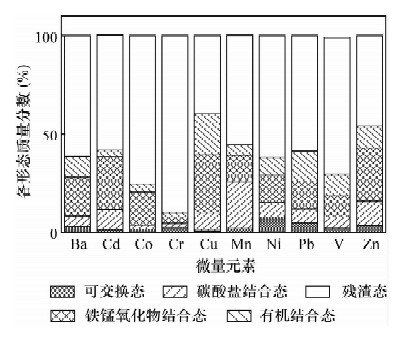Study on the Occurrence of Trace Elements in Low-sulfur Coal Gangue and Their Environmental Effect by Inductively Coupled Plasma-Optical Emission Spectrometry with Sequential Extraction Procedure
-
摘要:
This page contains the following errors:
error on line 1 at column 1: Start tag expected, '<' not foundBelow is a rendering of the page up to the first error.
Abstract: Coal gangue is the largest industrial solid waste in China. Trace elements in low-sulfur coal gangue samples from the Linhuan coal mining area in the Huaibei coalfield were measured by Inductively Coupled Plasma-Optical Emission Spectrometry(ICP-OES). Sequential extraction procedure and correlation analysis were employed to analyze the occurrence of trace elements in coal gangue. Meanwhile, the environmental effect of trace elements was studied by Risk Assessment Code(RAC). The results showed that trace elements(Ba, Co, Cr, Mn, Ni, Pb and V) were enriched in coal gangue compared with Huaibei coals and Chinese coals, in which the enrichment factors of Mn and V were greater than 1, indicating a certain risk of migration. Trace elements predominantly occur in residual and Fe-Mn oxide bound, the total quality fractions of which range from 68.87% to 92.93%. Cd, Co, Cu, Ni, Pb and Zn are hosted in sulfide minerals, V is hosted in clay minerals, and Mn mainly in carbonate minerals. The environmental hazard of trace elements was in order of Mn >Zn >Ni >Pb >Cd >Cu >Ba >V >Cr >Co, indicating that active Mn most likely pollutes the environment during the outdoor storage of coal gangue and the soil and water pollution induced by Mn should be of concern. -
煤矸石是煤炭开采、洗选加工过程中排放的固体废物,约占原煤总产量的15%左右,是我国工业固体废物的主要来源之一[1, 2]。排出的煤矸石露天堆存于地表,占用大量土地,在自然风化和淋溶过程中部分微量元素会迁移释放进入环境,极易造成周围土壤和水体的污染。煤矸石中微量元素的总量为评价其环境效应提供了重要的基础信息,但其迁移性和生物可利用性不仅与总量相关,而且在很大程度上取决于活性赋存状态所占的比例,因此研究煤矸石中微量元素的赋存状态非常必要。国内外一些学者研究了煤矸石中微量元素的含量特征及变化范围,遴选出多种高于环境背景值并值得关注的元素,包括Cd、Cu、Hg、Mn、Ni、Sn等[3, 4, 5, 6],但对其赋存状态的研究较少,尤其是对低硫煤矸石(全硫含量低于1%)的研究更是鲜见报道。
由于多种微量元素具有亲硫性,而低硫煤矸石含硫量较低,可能导致一些微量元素的含量和赋存状态不同于中高硫煤矸石。同时中国煤中低硫煤储量巨大,占煤炭总储量的58.7%,伴随低硫煤的开采将排出大量低硫煤矸石,堆积于矿区内,对生态环境产生危害[7, 8]。本文以低硫煤产区淮北临涣矿区的低硫煤矸石样品为研究对象,应用电感耦合等离子体发射光谱法(ICP-OES)测定了10种微量元素(Ba、Cd、Co、Cr、Cu、Mn、Ni、Pb、V、Zn)的含量,采用逐级化学提取法结合相关性分析研究了微量元素的赋存状态,并运用风险评价指数法(RAC)评价了其环境效应,以期为指导低硫煤矸石的堆放管理及其综合利用提供科学依据。
1. 样品采集与分析方法
1.1 样品采集与预处理
淮北矿区位于安徽省北部,是中国华东地区重要的煤炭工业基地,矿区内的低硫煤储量丰富,低硫煤矸石堆存量大、占地面积广。本研究选取淮北临涣矿区内一座大型煤矸石山,共采集7组煤矸石样品,包括:① 采用蛇形采样法沿煤矸石山从顶部到底部采集5组样品,其中1组为煤矸石山底部表层弱风化样品,其余4组样品采样深度为煤矸石表层以下20 cm;② 在堆放年限为5年以上的煤矸石堆表层采集风化煤矸石样品1组;③ 另采集巷道掘进过程中的新鲜煤矸石样品1组。
每组样品由5个子样混合而成,质量约1 kg,采集后使用塑封袋密封保存。采集的样品在室内自然风干,破碎后按四分法取10 g样品,经玛瑙研钵研磨后过100目尼龙筛,保存于棕色试剂瓶中,备用。
1.2 样品分析项目和测定方法
煤矸石样品分析项目包括全硫、灰分、Al、Ca、Fe和10种微量元素(Ba、Cd、Co、Cr、Cu、Mn、Ni、Pb、V、Zn)。其中,样品中全硫的测定采用WS-S101型自动测硫仪(长沙瑞翔科技有限公司),全硫测定结果为0.13%~0.46%,在低硫煤矸石含量范围内。灰分的测定依据国家标准GB/T 212—2008。微量元素赋存状态的研究采用Tessier逐级化学提取法[9],依据不同提取步骤,将其赋存状态分为可交换态、碳酸盐结合态、铁锰氧化物结合态、有机结合态、残渣态。运用XSP IntrepidⅡ型电感耦合等离子体发射光谱仪(美国Thermo公司)测定常量元素Al、Ca、Fe以及微量元素的总量和不同赋存状态下的含量。
各分析项目测试过程中,由空白样、平行样和标准样品(土壤成分分析标准物质GBW07403和国际标准煤样物质SRM1632b)进行质量控制,微量元素不同形态含量通过标准样品的回收率和微量元素的提取率(即5种提取形态下的提取总量与实测总量的比值)两方面进行质量控制,标准样品回收率反映其准确度,微量元素提取率反映其精密度。结果显示,平行样中微量元素的相对标准偏差(RSD)均小于10%,标准样品测定值均达到标准规定的准确度,微量元素的提取率均在80%~120%之间,表明了测试结果准确、可靠。
2. 低硫煤矸石中微量元素含量和赋存状态特征
2.1 微量元素含量特征
为研究低硫煤矸石中微量元素的富集程度,将所采集样品中的微量元素含量与淮北煤、中国煤、黑色页岩和克拉克值进行平行对比,样品中微量元素含量特征列于表 1。
表 1 煤矸石中微量元素的含量与文献数据的对比Table 1. The concentration of trace elements in coal gangue sample and comparison of analytical results with relative references微量
元素本研究的低硫煤矸石样品 淮北煤均值a
(mg/kg)中国煤均值b
(mg/kg)黑色页岩c
(mg/kg)克拉克值d
(mg/kg)富集系数
(EF)含量范围(mg/kg) 平均值(mg/kg) Ba 330.97~439.43 404.54 184.0 243.37 270~800 425.0 0.95 Cd 0.09~0.19 0.14 - 0.24 2~12 0.2 0.69 Co 11.20~32.01 17.34 9.2 7.05 10~30 25.0 0.69 Cr 39.13~53.39 46.60 34.2 15.35 50~160 100.0 0.47 Cu 4.78~13.57 9.34 48.2 18.35 35~150 55.0 0.17 Mn 103.29~373.02 194.64 20.0 125.00 200~800 100.0 1.95 Ni 10.75~35.08 18.18 16.4 13.71 40~140 75.0 0.24 Pb 22.65~38.17 29.61 18.0 15.55 10~40 - - V 108.47~216.20 180.10 108.0 35.05 100~400 135.0 1.33 Zn 26.18~87.63 51.28 304.0 42.18 60~300 70.0 0.73 注:a引自Zheng等[10]、杨萍玥等[11],b引自任德贻等[12],c引自Ketris等[13],d引自Taylor[14];EF为富集系数,即煤矸石中微量元素平均含量与克拉克值之比;“-”表示暂无数据。 表 1中的数据表明,富集系数(EF)最高的两种元素为Mn和V,其EF值分别为1.95、1.33,表明Mn和V相比于地壳背景值在低硫煤矸石中均有较大程度的富集。与淮北煤中微量元素的平均含量相比,Ba、Co、Cr、Mn、Ni、Pb和V在低硫煤矸石中相对富集,其中Mn的富集程度最高,是淮北煤平均值的9.7倍,Ba的含量也较高,是淮北煤均值的2.2倍;而Cd、Cu和Zn在低硫煤矸石中则相对亏损,远低于淮北煤平均值。对比中国煤中微量元素的平均含量,低硫煤矸石样品中除Cd和Cu外,其他元素均呈现相对富集的现象。崔龙鹏等[3]对采集自淮南煤田的44个煤矸石样品中微量元素丰度进行了研究,发现淮南煤田煤矸石中的Mn相对于当地煤的富集程度较大,Cr、Ni和Pb也存在一定程度的富集,可见Mn在煤矸石中的富集现象值得关注。
2.2 微量元素赋存状态特征
微量元素的迁移性和生物可利用性与其赋存状态密切相关,逐级化学提取法可快速、有效地为煤矸石中微量元素赋存状态的研究提供定量依据[15, 16, 17, 18]。相关性分析是间接判定微量元素赋存状态的一种常用方法,它依据微量元素含量与其他成分间的相关系数对微量元素的赋存状态进行判别[19, 20]。微量元素的含量与灰分、Al、Ca、Fe和S含量的相关性分析可以分别表征微量元素与无机矿物质、铝硅酸盐矿物、碳酸盐矿物和硫化物矿物之间的关系,进而判定微量元素在煤矸石中的载体矿物[21, 22, 23]。
逐级化学提取法所得5种相态是微量元素在煤矸石中的化学赋存形态,其每一种赋存形态都需以矿物质这种实体作为载体存在,一种赋存形态可能以多种矿物作为载体,同时一类矿物也可能对应多种赋存形态,例如硫化物矿物对应的赋存状态可为残渣态和铁锰氧化物结合态[19, 22]。图 1为本研究的低硫煤矸石样品中微量元素的逐级化学提取实验结果,表 2列举了微量元素与灰分、Al、Ca、Fe和S之间的皮尔逊(Pearson)相关系数(p < 0.05)。
表 2 煤矸石中微量元素与灰分、Al、Ca、Fe和S之间的Pearson相关系数(p < 0.05)Table 2. The Pearson's correlation coefficients (p < 0.05) of trace elements with Al, Ca, Fe, S and ash yield in coal gangue sample相关系数 r>0.7 0.7>r>0.5 0.5>r>0.35 与灰分 - Ba(0.521)
V(0.594)- 与Al V(0.967) - - 与Ca - - Mn(0.369) 与Fe Cu(0.627), V(0.816) Pb(0.541) Cr(0.481) 与S Cd(0.722), Co(0.703)
Cu(0.864), Ni(0.752)Cr(0.630)
Zn(0.523)Mn(0.397) 元素之间 Co-Ni=0.997,Co-Zn=0.876
Ni-Zn=0.863,Co-Mn=0.803
Mn-Ni=0.794,Cd-Zn=0.722- - 注:“-”表示没有在此相关性范围内的元素。 Ba主要以残渣态和铁锰氧化物结合态存在,两者质量分数之和为80.90%,表明其主要以无机结合态赋存于低硫煤矸石中。Ba与灰分的相关系数r=0.521,也表明Ba主要以无机结合态存在。
Cd的残渣态、铁锰氧化物结合态的质量分数分别为58.24%、26.81%,与S(r=0.722) 和Zn(r=0.722) 有较高的相关系数,表明Cd以黄铁矿、闪锌矿等硫化物矿物为载体赋存于低硫煤矸石中。Finkelman等[24]、王文峰等[25]认为煤中微量元素Cd通常与黄铁矿和闪锌矿中的铁离子、锌离子发生类质同象置换赋存于矿物中。
Co的残渣态、铁锰氧化物结合态的质量分数之和为91.98%,与S的相关系数r=0.703,表明Co在低硫煤矸石中赋存于硫化物矿物中。Zhou等[26]研究了淮南煤矸石中微量元素的赋存状态和环境效应,也发现Co与无机矿物联系紧密并赋存于硫化物矿物中。
Cr的残渣态含量较高(质量分数为89.84%),同时与Fe(r=0.481) 和S(r=0.630) 的相关系数较高,表明Cr赋存于硫化物矿物中。任德贻等[27]对辽宁沈北煤田的煤样中伴生元素的分布特征进行了研究,发现Cr除了与黏土矿物和有机质相关外,更主要与硫化物矿物有关。
Cu的残渣态的质量分数为39.62%,其次为铁锰氧化物结合态、有机结合态(质量分数分别为29.33%、20.87%)。Cu是一种强亲硫元素,与Fe(r=0.627) 和S(r=0.864) 的相关性较高,表明其在低硫煤矸石中赋存于黄铁矿等硫化物矿物中。Ribeiro等[20]研究了葡萄牙西北部Douro煤田煤矸石的岩相学和地球化学特征,也发现Cu主要与硫化物矿物结合,可能存在于黄铁矿和黄铜矿中。
Mn的残渣态含量最高,其次为碳酸盐结合态(质量分数为24.01%),与Ca、S的相关系数分别为r=0.369、r=0.397,表明Mn赋存于碳酸盐矿物、硫化物矿物中。Zhou等[18]研究了淮南煤田煤矸石中微量元素赋存状态和迁移特征,也发现煤矸石中Mn的赋存状态主要是硅酸盐结合态和碳酸盐结合态,此外还有一定量硫化物结合态的Mn存在。
Ni的残渣态、铁锰氧化物结合态的质量分数之和为75.41%,与S的相关系数r=0.752,表明Ni赋存于硫化物矿物中。
Pb的残渣态的质量分数为58.56%,其次为有机结合态、铁锰氧化物结合态(质量分数分别为15.33%、14.14%)。Pb与Fe(r=0.541) 有一定相关性,表明低硫煤矸石中的Pb不仅赋存于硫化物矿物中,而且还与有机质相关。方铅矿(PbS)是其最常见的赋存矿物[25]。
V的残渣态含量较高(质量分数为69.57%),与Al(r=0.967)、Fe(r=0.816)、灰分(r=0.594) 有较好的相关性,表明V主要以无机结合态存在,赋存于铝硅酸盐等黏土矿物中。Ribeiro等[20]和Zhou等[26]分别对葡萄牙西北部Douro煤田煤矸石和淮南煤田煤矸石中微量元素的赋存状态进行研究,也发现煤矸石中V主要赋存于黏土矿物等无机矿物中。
Zn的残渣态、铁锰氧化物结合态质量分数分别为45.74%、27.37%,与S(r=0.523) 有较高的相关系数,与Co(r=0.876) 和Ni(r=0.863) 这两种赋存于硫化物矿物中的元素也有很高的相关性,表明Zn赋存于硫化物矿物中,有强烈的亲硫性。
综合分析以上10种微量元素的赋存状态可知,微量元素具有相似的赋存形态,5种相态中均以残渣态含量最高,表明微量元素有很大一部分比例是以较稳定的形态存在。低硫煤矸石中的微量元素大部分赋存于硫化物矿物中,仅有个别元素(如Mn、V)分别赋存于碳酸盐矿物、黏土矿物中。由此可见,多种微量元素具有亲硫性,而低硫煤矸石的含硫量较低,影响了一些微量元素的赋存状态。
3. 低硫煤矸石中微量元素的环境效应
采用国际沉积物质量指南(SQGs)计算的微量元素对生物造成毒性效应的效应浓度低值(ERL)和效应浓度中值(ERM)对煤矸石中微量元素Cd、Cr、Cu、Ni、Pb和Zn进行评价。ERL是微量元素对沉积物中寄居的生物群极少产生有害效应的浓度值,ERM则是有可能产生有害效应的浓度值[28]。效应范围内的样品数所占的比例可反映微量元素对生物毒性作用的发生率,它被ERL和ERM分为三个区间:样品中微量元素的含量小于ERL、大于ERL且小于ERM、大于ERM。
煤矸石中微量元素在各效应范围的样品数所占比例列于表 3,所有样品中Cd、Cr、Cu、Pb和Zn含量都低于ERL,说明这5种元素基本不会出现生物毒性效应。14%的样品中Ni的含量超过了ERL值,但低于ERM值,产生生物毒性效应可能性极小。100%的样品中微量元素的含量均低于ERM值,表明总体上煤矸石中微量元素对生物造成毒性效应的可能性较小。
表 3 煤矸石中微量元素的环境效应Table 3. The environmental effect of trace elements in coal gangue sample微量元素 ERL~ERM
(mg/kg)各效应范围的样品数(%) 本项研究样品的RAC值 RAC值对应的风险程度a < ERL > ERL且 < ERM > ERM 范围 平均值 RAC值 风险程度 Ba - - - - 7.43~10.04 8.41
< 1
无Cd 1.2~9.6 100 0 0 8.69~14.53 11.7 Co - - - - 1.56~6.04 3.87
1~10
轻度Cr 81~370 100 0 0 3.61~6.40 4.7 Cu 34~270 100 0 0 8.64~12.64 10.19
10~30
中度Mn - - - - 23.87~27.93 26.02 Ni 20.9~51.6 86 14 0 14.43~16.13 15.27
30~50
重度Pb 46.7~218 100 0 0 9.65~16.65 11.97 V - - - - 5.38~10.65 8
>50
极严重Zn 150~410 100 0 0 14.49~17.49 15.76 注:a引自Jain[29]、刘春华等[30];ERL为效应浓度低值,ERM为效应浓度中值,RAC为风险评价指数;“-”表示暂无数据。 微量元素的迁移性和生物可利用性在很大程度上由其活性形态决定,不同赋存状态所产生的环境效应差异很大。风险评价指数法(RAC)是基于形态学研究产生的评价方法,通过分析环境中微量元素的活性形态判定其环境效应。对于Tessier五步提取法取得的微量元素赋存状态,将可交换态和碳酸盐结合态作为活性形态进行评价,活性形态占微量元素总量的比值即为RAC值[29, 30]。低硫煤矸石样品中微量元素的RAC值范围和平均值列于表 3,RAC值对应的风险程度也列于表 3。
通过分析微量元素的RAC值和对应的风险程度,煤矸石中10种微量元素对环境的危害性可排序为:Mn>Zn>Ni>Pb>Cd>Cu>Ba>V>Cr>Co。其中Co、Cr的RAC值最低,仅会引起非常轻度的生态风险;Ba、Cd、Cu、Pb和V产生的生态风险介于轻度和中度之间;Mn、Ni和Zn会造成中度生态风险,其中Mn的RAC值最高(23.87~27.93),表明活性形态的Mn对生态环境造成危害的可能性最大,由Mn可能造成的煤矸石山周边地区土壤及水体污染问题应当引起重视。
4. 结论
通过深入地研究淮北临涣矿区低硫煤矸石中10种微量元素的含量、赋存状态及其环境效应,认为低硫煤矸石中Ba、Co、Cr、Mn、Ni、Pb、V含量均高于淮北煤和中国煤的平均水平,并且Mn、V含量高于克拉克值,其迁移风险值得关注;微量元素主要以残渣态和铁锰氧化物结合态存在,两者质量分数之和为68.87%~92.93%,其中Cd、Co、Cr、Cu、Ni、Pb、Zn赋存于硫化物矿物中,V赋存于黏土矿物中,Mn赋存于碳酸盐矿物和硫化物矿物中;各微量元素的环境危害大小为:Mn>Zn>Ni>Pb>Cd>Cu>Ba>V>Cr>Co,其中Mn的风险评价指数值最高(23.87~27.93),低硫煤矸石在堆存过程中活性态Mn可能造成的污染问题应当引起重视。
本研究一方面对低硫煤矸石中微量元素进行形态分析,确定了其赋存状态;另一方面运用风险评价指数法分析了微量元素的活性形态,评价了其环境效应。研究成果是基于各种微量元素固有的地球化学特性,对研究其他矿区煤矸石中微量元素的赋存特征,指导煤矸石堆放管理、综合利用过程中环境效应评价具有借鉴意义。然而受客观条件的限制,所采集的样品数量、类型不够充足,微量元素赋存状态的研究方法均为间接方法,不能直观地反映出其赋存矿物,对研究结果有一定的影响。基于此,今后应运用直接方法(显微探针技术、谱学分析)和间接方法(化学形态分析、数理统计方法)相结合的手段从多方面深入研究微量元素赋存状态。
-
表 1 煤矸石中微量元素的含量与文献数据的对比
Table 1 The concentration of trace elements in coal gangue sample and comparison of analytical results with relative references
微量
元素本研究的低硫煤矸石样品 淮北煤均值a
(mg/kg)中国煤均值b
(mg/kg)黑色页岩c
(mg/kg)克拉克值d
(mg/kg)富集系数
(EF)含量范围(mg/kg) 平均值(mg/kg) Ba 330.97~439.43 404.54 184.0 243.37 270~800 425.0 0.95 Cd 0.09~0.19 0.14 - 0.24 2~12 0.2 0.69 Co 11.20~32.01 17.34 9.2 7.05 10~30 25.0 0.69 Cr 39.13~53.39 46.60 34.2 15.35 50~160 100.0 0.47 Cu 4.78~13.57 9.34 48.2 18.35 35~150 55.0 0.17 Mn 103.29~373.02 194.64 20.0 125.00 200~800 100.0 1.95 Ni 10.75~35.08 18.18 16.4 13.71 40~140 75.0 0.24 Pb 22.65~38.17 29.61 18.0 15.55 10~40 - - V 108.47~216.20 180.10 108.0 35.05 100~400 135.0 1.33 Zn 26.18~87.63 51.28 304.0 42.18 60~300 70.0 0.73 注:a引自Zheng等[10]、杨萍玥等[11],b引自任德贻等[12],c引自Ketris等[13],d引自Taylor[14];EF为富集系数,即煤矸石中微量元素平均含量与克拉克值之比;“-”表示暂无数据。 表 2 煤矸石中微量元素与灰分、Al、Ca、Fe和S之间的Pearson相关系数(p < 0.05)
Table 2 The Pearson's correlation coefficients (p < 0.05) of trace elements with Al, Ca, Fe, S and ash yield in coal gangue sample
相关系数 r>0.7 0.7>r>0.5 0.5>r>0.35 与灰分 - Ba(0.521)
V(0.594)- 与Al V(0.967) - - 与Ca - - Mn(0.369) 与Fe Cu(0.627), V(0.816) Pb(0.541) Cr(0.481) 与S Cd(0.722), Co(0.703)
Cu(0.864), Ni(0.752)Cr(0.630)
Zn(0.523)Mn(0.397) 元素之间 Co-Ni=0.997,Co-Zn=0.876
Ni-Zn=0.863,Co-Mn=0.803
Mn-Ni=0.794,Cd-Zn=0.722- - 注:“-”表示没有在此相关性范围内的元素。 表 3 煤矸石中微量元素的环境效应
Table 3 The environmental effect of trace elements in coal gangue sample
微量元素 ERL~ERM
(mg/kg)各效应范围的样品数(%) 本项研究样品的RAC值 RAC值对应的风险程度a < ERL > ERL且 < ERM > ERM 范围 平均值 RAC值 风险程度 Ba - - - - 7.43~10.04 8.41
< 1
无Cd 1.2~9.6 100 0 0 8.69~14.53 11.7 Co - - - - 1.56~6.04 3.87
1~10
轻度Cr 81~370 100 0 0 3.61~6.40 4.7 Cu 34~270 100 0 0 8.64~12.64 10.19
10~30
中度Mn - - - - 23.87~27.93 26.02 Ni 20.9~51.6 86 14 0 14.43~16.13 15.27
30~50
重度Pb 46.7~218 100 0 0 9.65~16.65 11.97 V - - - - 5.38~10.65 8
>50
极严重Zn 150~410 100 0 0 14.49~17.49 15.76 注:a引自Jain[29]、刘春华等[30];ERL为效应浓度低值,ERM为效应浓度中值,RAC为风险评价指数;“-”表示暂无数据。 -
-
期刊类型引用(7)
1. 孙红宾,臧慧媛,张欣,朱云,王蕾. 流动注射法测定咸水和半咸水中的硝酸盐氮和亚硝酸盐氮. 岩矿测试. 2023(05): 934-943 .  本站查看
本站查看
2. 李小莉,高新华,王毅民,邓赛文,王祎亚,李松. X射线荧光在地质材料卤族元素分析中的应用评介. 光谱学与光谱分析. 2022(04): 997-1009 .  百度学术
百度学术
3. 闵宁. HR-ICP-MS法测定淮北煤田太灰水中溴和碘. 保山学院学报. 2022(05): 46-50 .  百度学术
百度学术
4. 王毅民,邓赛文,王祎亚,李松. X射线荧光光谱在矿石分析中的应用评介——总论. 冶金分析. 2020(10): 32-49 .  百度学术
百度学术
5. 石华,刘氘,陶丽萍. 容量法测定卤水中氯元素干扰扣除方法. 化学工程师. 2019(10): 38-40 .  百度学术
百度学术
6. 李可及. 熔融制样X射线荧光光谱法测定岩盐中的主量成分. 岩矿测试. 2016(03): 290-294 .  本站查看
本站查看
7. 姜贞贞,刘高令,王祝,李明礼,卓玛曲西,邵蓓,董锐,王伟. 电感耦合等离子体质谱法测定高海拔地区地热水中的微量元素. 岩矿测试. 2016(05): 475-480 .  本站查看
本站查看
其他类型引用(1)



 下载:
下载:

 京公网安备 11010202008159号
京公网安备 11010202008159号